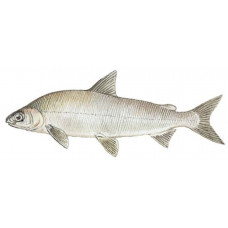Latin name
Coregonus clupeaformis
Other names
High back, bow back, buffalo back, or humpback whitefish; common whitefish; eastern whitefish; Great Lakes whitefish; inland whitefish; Sault whitefish; gizzard fish; Cree: atekamek; French: grand corégone.
Identification
A slender, elongated species, the lake whitefish is silvery white with an olive or pale greenish-brown back that turns dark brown to midnight blue or black in some inland lake specimens. It also has white fins and a dark tail. The mouth is subterminal, the snout protruding beyond it, with a double flap of skin between the nostrils. The tail is deeply forked and there is a fat fin. Lake whitefish are sometimes called "humpbacked" because the head is small relative to body length, and older individuals may have a hump behind the head. It has 10 to 14 anal rays, 70 to 97 scales along the lateral line, and 19 to 33 gill lobes. The body is more laterally compressed than that of the round or mountain whitefish, which belong to a separate genus, the round whitefish.
Distribution
Lake whitefish are found throughout Alaska and Canada. In the continental United States, it is found in central Minnesota and the Great Lakes, from New York to Maine. Transplanted populations exist in Washington, Idaho, and Montana. It has been introduced into high Andean lakes in several South American countries.
Habitat
Lake whitefish are named for their primary habitat, large, deep lakes, but they also inhabit large rivers. The fish prefer water temperatures of 50° to 55°F and can be found in brackish water.
Size
Lake whitefish typically reach 18 inches in length and weigh between 2 and 4 pounds. Some reach 31 inches, and the world record for any tackle is believed to be a 14-pound, 6-ounce fish caught in Ontario, Canada in 1984. The average whitefish caught by anglers ranges from 1 to 2 pounds. Occasionally, fish weighing 4 or 5 pounds or more are caught. This species can live to be 18 years old.
Life history and Behavior
Spawning occurs in late fall when the fish migrate to shallow sandy bottoms or shoals in large lakes or tributaries. Eggs are deposited randomly on the bottom by females, who can lay up to 12,000 eggs per pound of body weight. These fish do not build nests, and the parents return to the depths after spawning, leaving the eggs unprotected on the spawning grounds until they hatch the following spring. By early summer, juvenile fish move from shallow coastal areas to deeper waters.
Food and feeding habits
Adult lake whitefish feed primarily on aquatic insect larvae, mollusks and amphipods, and other small fish and fish eggs, including their own. Juveniles feed on plankton.
Reproduction
No information
| Classification | |
| Phylum | Chordata |
| Class | Actinopterygii |
| Squad | Salmoniformes |
| Family | Salmonidae |
| Genus | Coregonus |
| Species | C. clupeaformis |
| Features | |
| Conservation status | Secure |
| Habitat | Pelagic |
| Life span, years | 18 |
| Maximum body weight, kg | 6.5 |
| Maximum length, cm | 79 |
| Sailing speed, m/s | No information |
| Threat to people | Edible |
| Way of eating | Bentophage |


